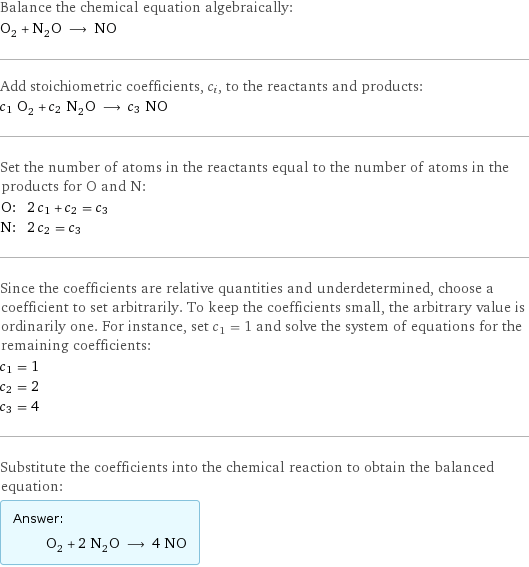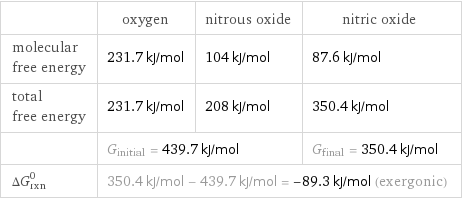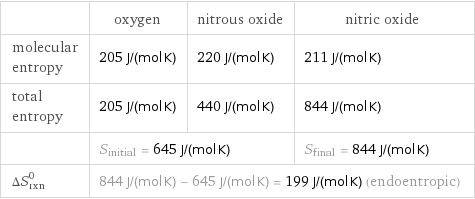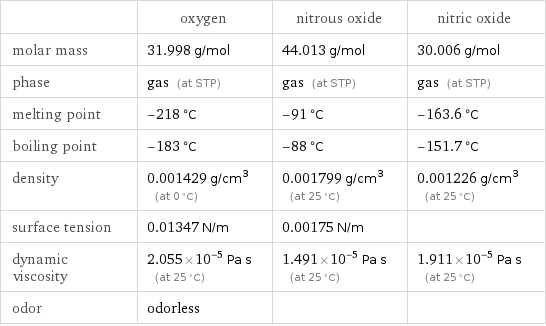Input interpretation

O_2 oxygen + N_2O nitrous oxide ⟶ NO nitric oxide
Balanced equation

Balance the chemical equation algebraically: O_2 + N_2O ⟶ NO Add stoichiometric coefficients, c_i, to the reactants and products: c_1 O_2 + c_2 N_2O ⟶ c_3 NO Set the number of atoms in the reactants equal to the number of atoms in the products for O and N: O: | 2 c_1 + c_2 = c_3 N: | 2 c_2 = c_3 Since the coefficients are relative quantities and underdetermined, choose a coefficient to set arbitrarily. To keep the coefficients small, the arbitrary value is ordinarily one. For instance, set c_1 = 1 and solve the system of equations for the remaining coefficients: c_1 = 1 c_2 = 2 c_3 = 4 Substitute the coefficients into the chemical reaction to obtain the balanced equation: Answer: | | O_2 + 2 N_2O ⟶ 4 NO
Structures

+ ⟶
Names

oxygen + nitrous oxide ⟶ nitric oxide
Reaction thermodynamics
Enthalpy

| oxygen | nitrous oxide | nitric oxide molecular enthalpy | 0 kJ/mol | 81.6 kJ/mol | 91.3 kJ/mol total enthalpy | 0 kJ/mol | 163.2 kJ/mol | 365.2 kJ/mol | H_initial = 163.2 kJ/mol | | H_final = 365.2 kJ/mol ΔH_rxn^0 | 365.2 kJ/mol - 163.2 kJ/mol = 202 kJ/mol (endothermic) | |
Gibbs free energy

| oxygen | nitrous oxide | nitric oxide molecular free energy | 231.7 kJ/mol | 104 kJ/mol | 87.6 kJ/mol total free energy | 231.7 kJ/mol | 208 kJ/mol | 350.4 kJ/mol | G_initial = 439.7 kJ/mol | | G_final = 350.4 kJ/mol ΔG_rxn^0 | 350.4 kJ/mol - 439.7 kJ/mol = -89.3 kJ/mol (exergonic) | |
Entropy

| oxygen | nitrous oxide | nitric oxide molecular entropy | 205 J/(mol K) | 220 J/(mol K) | 211 J/(mol K) total entropy | 205 J/(mol K) | 440 J/(mol K) | 844 J/(mol K) | S_initial = 645 J/(mol K) | | S_final = 844 J/(mol K) ΔS_rxn^0 | 844 J/(mol K) - 645 J/(mol K) = 199 J/(mol K) (endoentropic) | |
Equilibrium constant
![Construct the equilibrium constant, K, expression for: O_2 + N_2O ⟶ NO Plan: • Balance the chemical equation. • Determine the stoichiometric numbers. • Assemble the activity expression for each chemical species. • Use the activity expressions to build the equilibrium constant expression. Write the balanced chemical equation: O_2 + 2 N_2O ⟶ 4 NO Assign stoichiometric numbers, ν_i, using the stoichiometric coefficients, c_i, from the balanced chemical equation in the following manner: ν_i = -c_i for reactants and ν_i = c_i for products: chemical species | c_i | ν_i O_2 | 1 | -1 N_2O | 2 | -2 NO | 4 | 4 Assemble the activity expressions accounting for the state of matter and ν_i: chemical species | c_i | ν_i | activity expression O_2 | 1 | -1 | ([O2])^(-1) N_2O | 2 | -2 | ([N2O])^(-2) NO | 4 | 4 | ([NO])^4 The equilibrium constant symbol in the concentration basis is: K_c Mulitply the activity expressions to arrive at the K_c expression: Answer: | | K_c = ([O2])^(-1) ([N2O])^(-2) ([NO])^4 = ([NO])^4/([O2] ([N2O])^2)](../image_source/7e229eff9371567c1bb02d4e2e47d177.png)
Construct the equilibrium constant, K, expression for: O_2 + N_2O ⟶ NO Plan: • Balance the chemical equation. • Determine the stoichiometric numbers. • Assemble the activity expression for each chemical species. • Use the activity expressions to build the equilibrium constant expression. Write the balanced chemical equation: O_2 + 2 N_2O ⟶ 4 NO Assign stoichiometric numbers, ν_i, using the stoichiometric coefficients, c_i, from the balanced chemical equation in the following manner: ν_i = -c_i for reactants and ν_i = c_i for products: chemical species | c_i | ν_i O_2 | 1 | -1 N_2O | 2 | -2 NO | 4 | 4 Assemble the activity expressions accounting for the state of matter and ν_i: chemical species | c_i | ν_i | activity expression O_2 | 1 | -1 | ([O2])^(-1) N_2O | 2 | -2 | ([N2O])^(-2) NO | 4 | 4 | ([NO])^4 The equilibrium constant symbol in the concentration basis is: K_c Mulitply the activity expressions to arrive at the K_c expression: Answer: | | K_c = ([O2])^(-1) ([N2O])^(-2) ([NO])^4 = ([NO])^4/([O2] ([N2O])^2)
Rate of reaction
![Construct the rate of reaction expression for: O_2 + N_2O ⟶ NO Plan: • Balance the chemical equation. • Determine the stoichiometric numbers. • Assemble the rate term for each chemical species. • Write the rate of reaction expression. Write the balanced chemical equation: O_2 + 2 N_2O ⟶ 4 NO Assign stoichiometric numbers, ν_i, using the stoichiometric coefficients, c_i, from the balanced chemical equation in the following manner: ν_i = -c_i for reactants and ν_i = c_i for products: chemical species | c_i | ν_i O_2 | 1 | -1 N_2O | 2 | -2 NO | 4 | 4 The rate term for each chemical species, B_i, is 1/ν_i(Δ[B_i])/(Δt) where [B_i] is the amount concentration and t is time: chemical species | c_i | ν_i | rate term O_2 | 1 | -1 | -(Δ[O2])/(Δt) N_2O | 2 | -2 | -1/2 (Δ[N2O])/(Δt) NO | 4 | 4 | 1/4 (Δ[NO])/(Δt) (for infinitesimal rate of change, replace Δ with d) Set the rate terms equal to each other to arrive at the rate expression: Answer: | | rate = -(Δ[O2])/(Δt) = -1/2 (Δ[N2O])/(Δt) = 1/4 (Δ[NO])/(Δt) (assuming constant volume and no accumulation of intermediates or side products)](../image_source/d1920bfc319ff9b362be5098cf1b4ec8.png)
Construct the rate of reaction expression for: O_2 + N_2O ⟶ NO Plan: • Balance the chemical equation. • Determine the stoichiometric numbers. • Assemble the rate term for each chemical species. • Write the rate of reaction expression. Write the balanced chemical equation: O_2 + 2 N_2O ⟶ 4 NO Assign stoichiometric numbers, ν_i, using the stoichiometric coefficients, c_i, from the balanced chemical equation in the following manner: ν_i = -c_i for reactants and ν_i = c_i for products: chemical species | c_i | ν_i O_2 | 1 | -1 N_2O | 2 | -2 NO | 4 | 4 The rate term for each chemical species, B_i, is 1/ν_i(Δ[B_i])/(Δt) where [B_i] is the amount concentration and t is time: chemical species | c_i | ν_i | rate term O_2 | 1 | -1 | -(Δ[O2])/(Δt) N_2O | 2 | -2 | -1/2 (Δ[N2O])/(Δt) NO | 4 | 4 | 1/4 (Δ[NO])/(Δt) (for infinitesimal rate of change, replace Δ with d) Set the rate terms equal to each other to arrive at the rate expression: Answer: | | rate = -(Δ[O2])/(Δt) = -1/2 (Δ[N2O])/(Δt) = 1/4 (Δ[NO])/(Δt) (assuming constant volume and no accumulation of intermediates or side products)
Chemical names and formulas

| oxygen | nitrous oxide | nitric oxide formula | O_2 | N_2O | NO name | oxygen | nitrous oxide | nitric oxide IUPAC name | molecular oxygen | nitrous oxide | nitric oxide
Substance properties

| oxygen | nitrous oxide | nitric oxide molar mass | 31.998 g/mol | 44.013 g/mol | 30.006 g/mol phase | gas (at STP) | gas (at STP) | gas (at STP) melting point | -218 °C | -91 °C | -163.6 °C boiling point | -183 °C | -88 °C | -151.7 °C density | 0.001429 g/cm^3 (at 0 °C) | 0.001799 g/cm^3 (at 25 °C) | 0.001226 g/cm^3 (at 25 °C) surface tension | 0.01347 N/m | 0.00175 N/m | dynamic viscosity | 2.055×10^-5 Pa s (at 25 °C) | 1.491×10^-5 Pa s (at 25 °C) | 1.911×10^-5 Pa s (at 25 °C) odor | odorless | |
Units
